Optimization of Surface-Enhanced Raman Spectroscopy Detection Conditions for Interaction between Gonyautoxin and Its Aptamer
Abstract
:1. Introduction
2. Results and Discussion
2.1. SERS Optimization in Four Kinds of Buffers
2.1.1. Water as the Solvent
2.1.2. Sodium Acetate Buffer as the Solvent
2.1.3. Sodium Phosphate Buffer as the Solvent
2.1.4. Tris-HCl Buffer as the Solvent
2.2. The Interaction Mechanism between GTX1/4 and GO18
2.2.1. Establishment and Optimization of SERS Detection Conditions
2.2.2. SERS Condition Optimization
2.2.3. The Interaction between GTX1/4 and GO18
3. Conclusions
4. Materials and Methods
4.1. Samples and Reagents
4.2. Experimental Facilities
4.3. Preparation of Silver Colloids
4.4. Sample Processing
4.5. SERS Detection Method
4.6. Data Preprocessing
Supplementary Materials
Author Contributions
Funding
Institutional Review Board Statement
Informed Consent Statement
Data Availability Statement
Conflicts of Interest
References
- Kinghorn, A.B.; Fraser, L.A.; Lang, S.; Shiu, S.C.C.; Tanner, J.A. Aptamer Bioinformatics. Int. J. Mol. Sci. 2017, 18, 2516. [Google Scholar] [CrossRef] [PubMed] [Green Version]
- Negri, P.; Chen, G.; Kage, A.; Nitsche, A.; Naumann, D.; Xu, B.; Dluhy, R.A. Direet opical dection of viral nucleoprotein binding to an anti-influenza aptamer. Anal. Chem. 2012, 84, 5501–5508. [Google Scholar] [CrossRef] [PubMed] [Green Version]
- Khan, R.; Sherazi, T.A.; Catanante, G.; Rasheed, S.; Marty, J.L.; Hayat, A. Switchable fluorescence sensor toward PAT via CA-MWCNTs quenched aptamer-tagged carboxyfluorescein. Food Chem. 2020, 312, 126048–126073. [Google Scholar] [CrossRef] [PubMed]
- Ye, W.; Liu, T.; Zhang, W.; Zhu, M.; Liu, Z.; Kong, Y.; Liu, S. Marine Toxins Detection by Biosensors Based on Aptamers. Toxins 2019, 12, 1. [Google Scholar] [CrossRef] [Green Version]
- Cho, Y.S.; Lee, E.J.; Lee, G.H.; Hah, S.S. Aptamer selection for fishing of palladium ion using graphene oxide-adsorbed nanoparticles. Bioorg. Med. Chem. Lett. 2015, 25, 5536–5539. [Google Scholar] [CrossRef]
- Zununi Vahed, S.; Fathi, N.; Samiei, M.; Maleki Dizaj, S.; Sharifi, S. Targeted cancer drug delivery with aptamer-functionalized polymeric nanoparticles. J. Drug Target 2019, 27, 292–299. [Google Scholar] [CrossRef]
- Lin, N.; Wu, L.; Xu, X.; Wu, Q.; Wang, Y.; Shen, H.; Song, Y.; Wang, H.; Zhu, Z.; Kang, D.; et al. Aptamer generated by Cell-SELEX for specific targeting of human glioma Cells. ACS Appl. Mater. Interfaces 2021, 13, 9306–9315. [Google Scholar] [CrossRef] [PubMed]
- Djordjevic, M. SELEX experiments: New prospects, applications and data analysis in inferring regulatory pathways. Biomol. Eng. 2007, 24, 179–189. [Google Scholar] [CrossRef]
- Li, T.; Li, B.; Dong, S. Adaptive recognition of small molecules by nucleic acid aptamers through a label-free approach. Chemistry 2007, 13, 6718–6723. [Google Scholar] [CrossRef]
- Kumar Kulabhusan, P.; Hussain, B.; Yuce, M. Current perspectives on aptamers as diagnostic tools and therapeutic agents. Pharmaceutics 2020, 12, 646. [Google Scholar] [CrossRef] [PubMed]
- Chavez, J.L.; Lyon, W.; Kelley-Loughnane, N.; Stone, M.O. Theophylline detection using an aptamer and DNA-gold nanoparticle conjugates. Biosens. Bioelectron. 2010, 26, 23–28. [Google Scholar] [CrossRef] [PubMed]
- Neves, M.A.; Reinstein, O.; Johnson, P.E. Defining a stem length-dependent binding mechanism for the cocaine-binding aptamer. A combined NMR and calorimetry study. Biochemistry 2010, 49, 8478–8487. [Google Scholar] [CrossRef] [PubMed]
- Gonzalez-Fernandez, E.; de-los-Santos-Alvarez, N.; Miranda-Ordieres, A.J.; Lobo-Castanon, M.J. SPR evaluation of binding kinetics and affinity study of modified RNA aptamers towards small molecules. Talanta 2012, 99, 767–773. [Google Scholar] [CrossRef] [PubMed]
- Baaske, P.; Wienken, C.J.; Reineck, P.; Duhr, S.; Braun, D. Optical thermophoresis for quantifying the buffer dependence of aptamer binding. Angew. Chem. Int. Ed. Engl. 2010, 49, 2238–2241. [Google Scholar] [CrossRef]
- Zheng, X.; Hu, B.; Gao, S.X.; Liu, D.J.; Sun, M.J.; Jiao, B.H.; Wang, L.H. A saxitoxin-binding aptamer with higher affinity and inhibitory activity optimized by rational site-directed mutagenesis and truncation. Toxicon 2015, 101, 41–47. [Google Scholar] [CrossRef] [Green Version]
- Xu, G.; Zhao, J.; Liu, N.; Yang, M.; Zhao, Q.; Li, C.; Liu, M. Sucture-guided post-SELEX optimization of an ochratoxin A aptamer. Nucleic Acids Res. 2019, 47, 5963–5972. [Google Scholar] [CrossRef] [PubMed]
- Lee, B.H.; Nguyen, V.T.; Gu, M.B. Highly sensitive detection of 25- HydroxyvitaminD3 by using a target-induced displacement of aptamer. Biosens. Bioelectron. 2017, 88, 174–180. [Google Scholar] [CrossRef]
- Casanova-Morales, N.; Figueroa, N.L.; Alfaro, K.; Montenegro, F.; Barrera, N.P.; Maze, J.R.; Wilson, C.A.M.; Conejeros, P. Structural characterization of the saxitoxin targeting APTSTX1 aptamer using optical tweezers and molecular dynamics simulations. PLoS ONE 2019, 14, e0222468–e0222481. [Google Scholar] [CrossRef] [Green Version]
- Dorr, F.A.; Kovacevi, B.; Maksi, Z.B.; Pinto, E.; Volmer, D.A. Intriguing differences in the gas-phase dissociation behavior of protonated and deprotonated gonyautoxin epimers. J. Am. Soc. Mass. Spectrom. 2011, 22, 2011–2020. [Google Scholar] [CrossRef] [Green Version]
- Gao, S.X.; Hu, B.; Zheng, X.; Cao, Y.; Liu, D.J.; Sun, M.G.; Jiao, B.H.; Wang, L.H. Gonyautoxin 1/4 aptamers with high-affinity and high-specificity: From efficient selection to aptasensor application. Biosens. Bioclectron. 2016, 79, 938–944. [Google Scholar] [CrossRef] [PubMed]
- Song, M.H.; Li, G.; Zhang, Q.; Liu, J.; Huang, Q. De novo post-SELEX optimization of a G-quadruplex DNA aptamer binding to marine toxin gonyautoxin 1/4. Comput. Struct. Biotechnol. J. 2020, 18, 3425–3433. [Google Scholar] [CrossRef] [PubMed]
- Zong, C.; Xu, M.; Xu, L.J.; Wei, T.; Ma, X.; Zheng, X.S.; Hu, R.; Ren, B. Surface-enhanced raman spectroscopy for bioanalysis: Reliability and challenges. Chem. Rev. 2018, 118, 4946–4980. [Google Scholar] [CrossRef] [PubMed]
- Bell, S.E.J.; Sirimuthu, N.M.S. Surface-enhanced Raman spectroscopy (SERS) for sub-micromolar detection of DNA/RNA mononucleotides. J. Am. Chem. Soc. 2006, 128, 15580–15581. [Google Scholar] [CrossRef] [PubMed]
- Papadopoulou, E.; Bell, S.E. Label-free detection of single-base mismatches in DNA by surface-enhanced Raman spectroscopy. Angew. Chem. Int. Ed. Engl. 2011, 50, 9058–9061. [Google Scholar] [CrossRef] [PubMed] [Green Version]
- Cialla, D.; Marz, A.; Bohme, R.; Theil, F.; Weber, K.; Schmitt, M.; Popp, J. Surface- enhanced Raman spectroscopy (SERS): Progress and trends. Anal. Bioanal. Chem. 2012, 403, 27–54. [Google Scholar] [CrossRef] [PubMed]
- Li, Y.; Wang, Y.; Fu, C.; Wu, Y.; Cao, H.; Shi, W.; Jung, Y.M. A simple enzyme-free SERS sensor for the rapid and sensitive detection of hydrogen peroxide in food. Analyst 2020, 145, 607–612. [Google Scholar] [CrossRef]
- Chen, D.; Ning, P.; Zhang, Y.; Jing, J.; Zhang, M.; Zhang, L.; Huang, J.; He, X.; Fu, T.; Song, Z.; et al. Ta@Ag porous array with high stability and biocompatibility for SERS sensing of bacteria. ACS Appl. Mater. Interfaces 2020, 12, 20138–20144. [Google Scholar] [CrossRef] [PubMed]
- Ma, L.M.; Li, J.H.; Zou, S.M.; Zhang, Z.J. Ag nanorods-oxide hybrid array substrates: Synthesis, characterization, and applications in surface-enhanced Raman scattering. Sensors 2017, 17, 1895. [Google Scholar] [CrossRef] [PubMed] [Green Version]
- Kang, T.; Yoo, S.M.; Yoon, L.; Lee, S.Y.; Kim, B. Patterned multiplex pathogen DNA detection by Au particle-on-wire SERS sensor. Nano Lett. 2010, 10, 1189–1193. [Google Scholar] [CrossRef] [PubMed] [Green Version]
- Laing, S.; Gracie, K.; Faulds, K. Multiplex in vitro detection using SERS. Chem. Soc. Rev. 2016, 45, 1901–1918. [Google Scholar] [CrossRef] [PubMed] [Green Version]
- Nava, G.; Ceccarello, E.; Giavazzi, F.; Salina, M.; Damin, F.; Chiari, M.; Buscaglia, M.; Bellini, T.; Zanchetta, G. Label-free detection of DNA single-base mismatches using a simple reflectance-based optical technique. Phys. Chem. Chem. Phys. 2016, 18, 13395–13402. [Google Scholar] [CrossRef] [PubMed] [Green Version]
- Papadopoulou, E.; Bell, S.E. Label-free detection of nanomolar unmodified single- and double-stranded DNA by using surface-enhanced Raman spectroscopy on Ag and Au colloids. Chemistry 2012, 18, 5394–5400. [Google Scholar] [CrossRef] [PubMed]
- Xu, L.J.; Zong, C.; Zheng, X.S.; Hu, P.; Feng, J.M.; Ren, B. Label-free detection of native proteins by surface-enhanced Raman spectroscopy using iodide-modified nanoparticles. Anal. Chem. 2014, 86, 2238–2245. [Google Scholar] [CrossRef] [PubMed]
- Li, Y.; Han, X.; Yan, Y.; Cao, Y.; Xiang, X.; Wang, S.; Zhao, B.; Guo, X. Label-Free detection of tetramolecular i-motifs by surface-enhanced Raman spectroscopy. Anal. Chem. 2018, 90, 2996–3000. [Google Scholar] [CrossRef] [PubMed] [Green Version]
- Liao, X.J.; Zhang, C.Y.; Machuki, J.O.; Wen, X.Q.; Tang, Q.L.; Shi, H.L.; Gao, F.L. Proximity hybridization-triggered DNA assembly for label-free surface-enhanced Raman spectroscopic bioanalysis. Analytica. Chim. Acta 2020, 1139, 42–49. [Google Scholar] [CrossRef] [PubMed]
- Xu, L.J.; Lei, Z.C.; Li, J.; Zong, C.; Yang, C.J.; Ren, B. Label-free surface-enhanced Raman spectroscopy detection of DNA with single-base sensitivity. J. Am. Chem. Soc. 2015, 137, 5149–5154. [Google Scholar] [CrossRef]
- Lee, P.; Meisel, D. Adsorption and surface-enhanced Raman of dyes on silver and gold sols. J. Phys. Chem. 1982, 86, 3391–3395. [Google Scholar] [CrossRef]
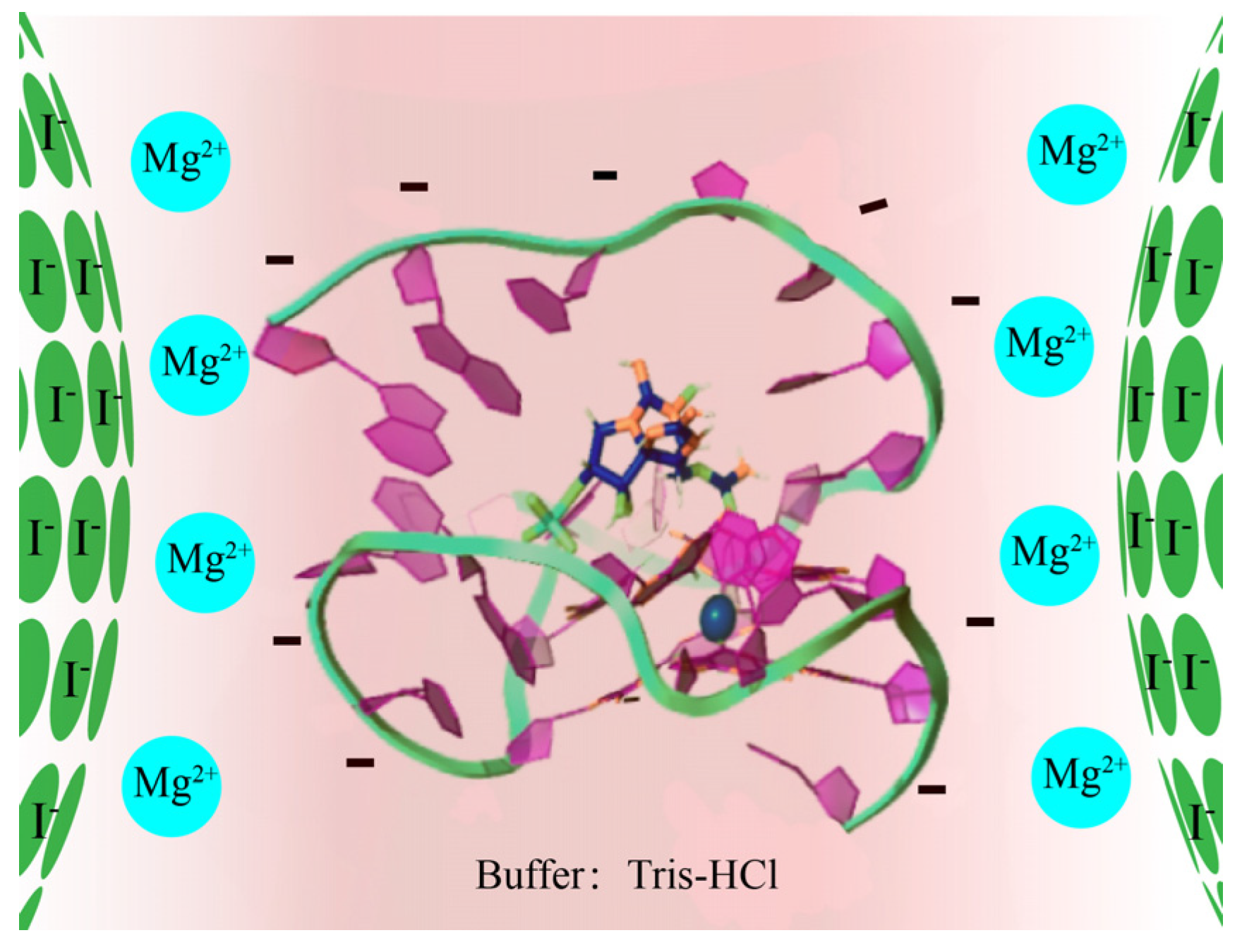

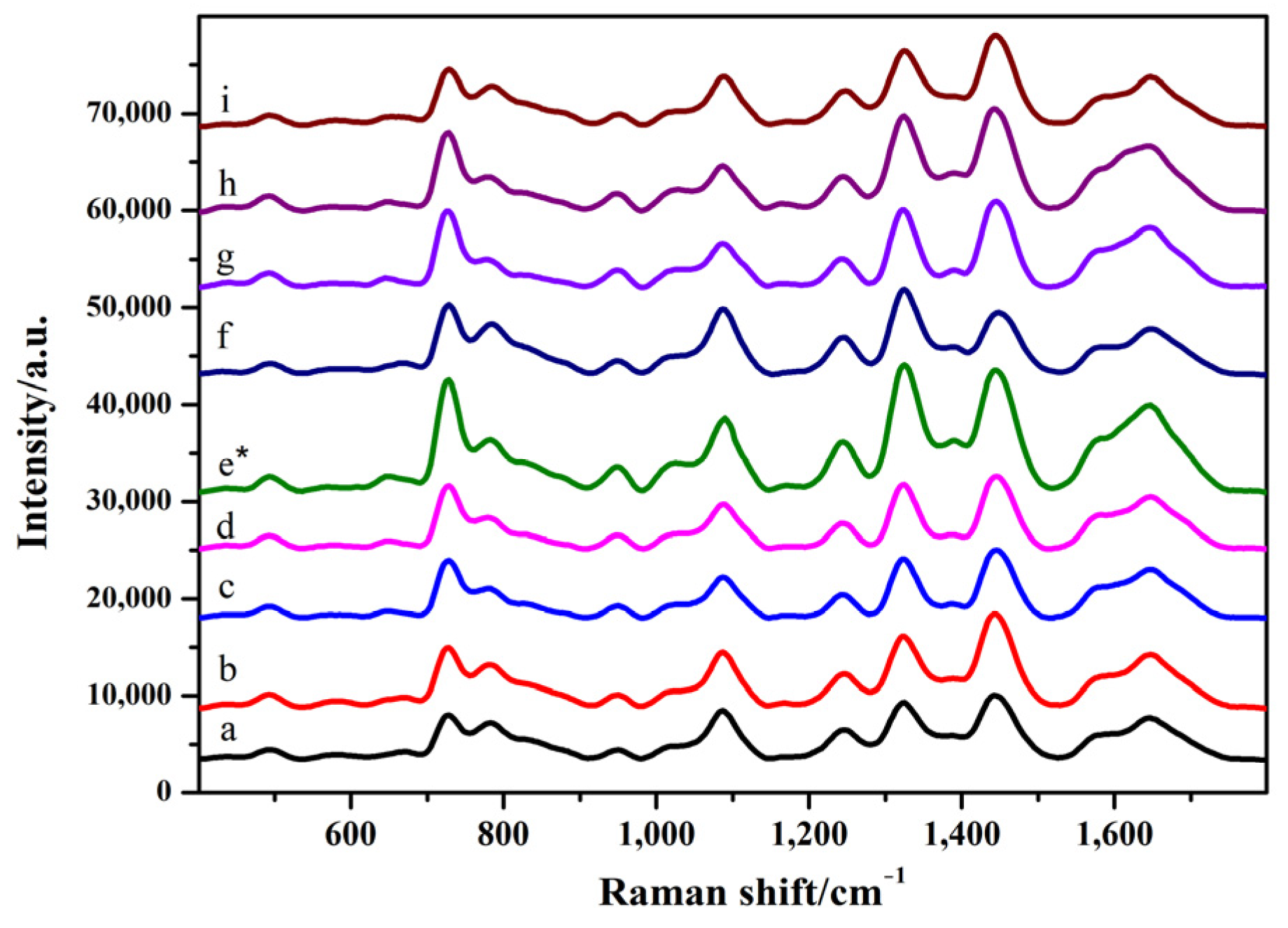

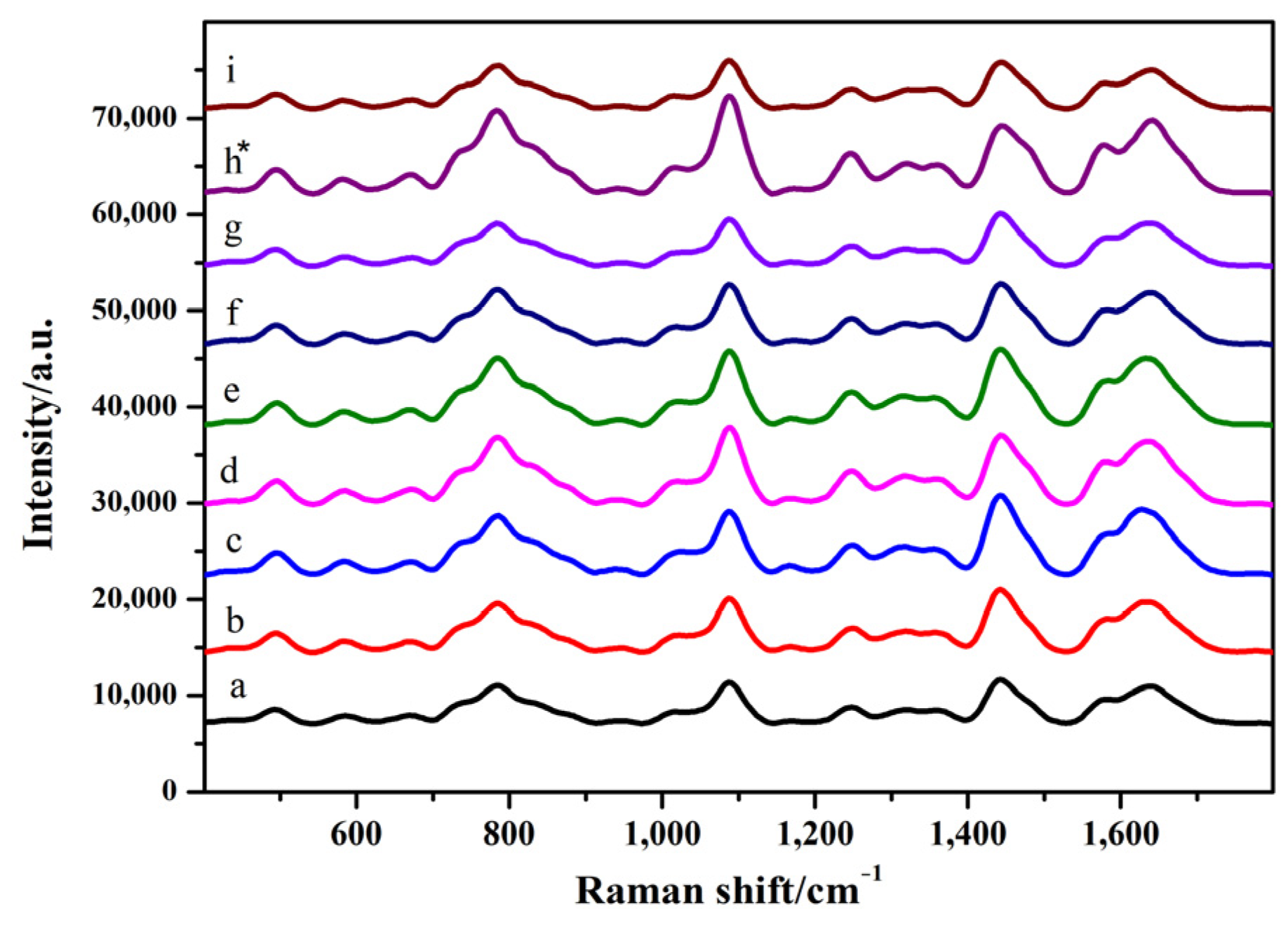
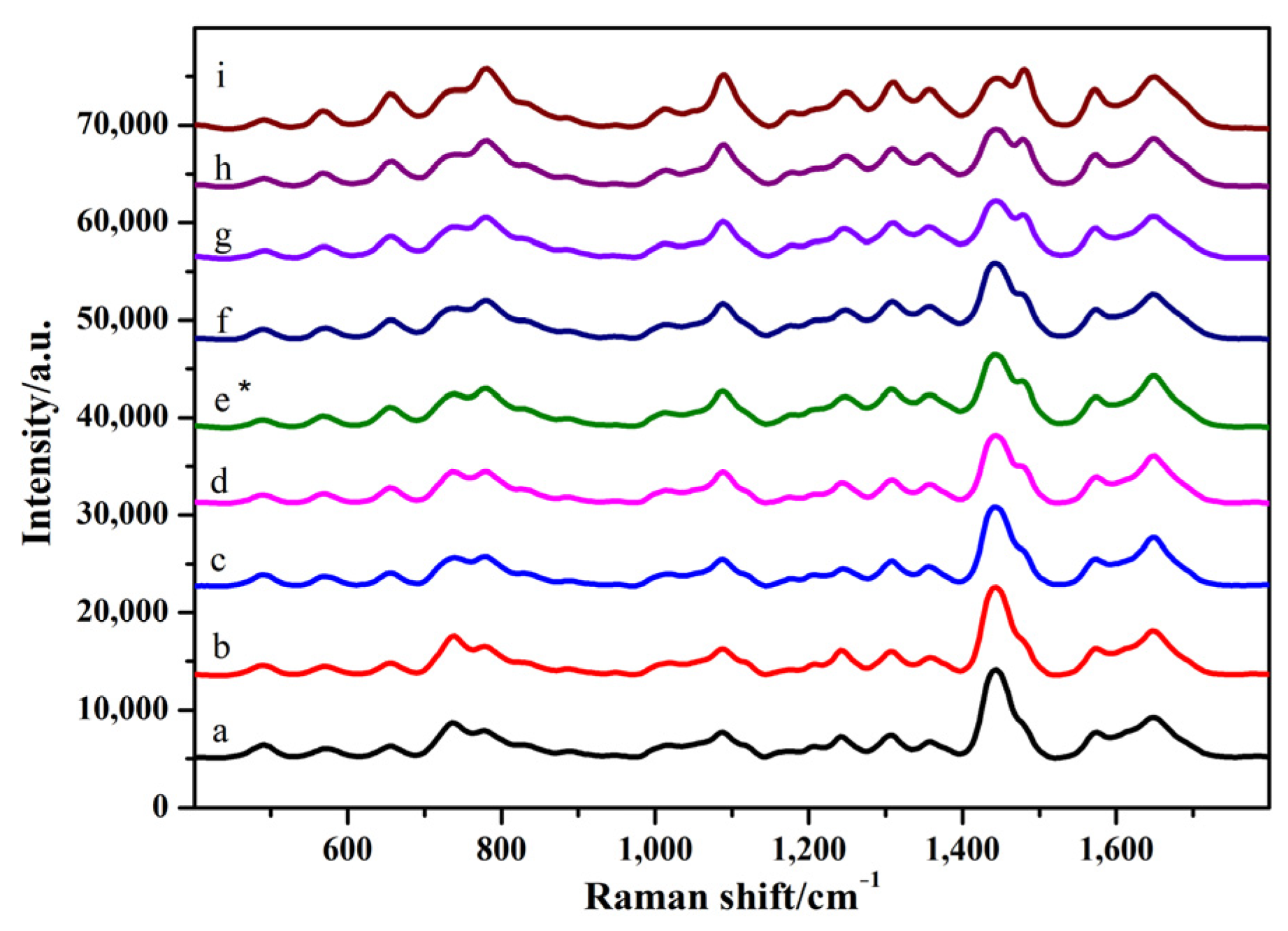
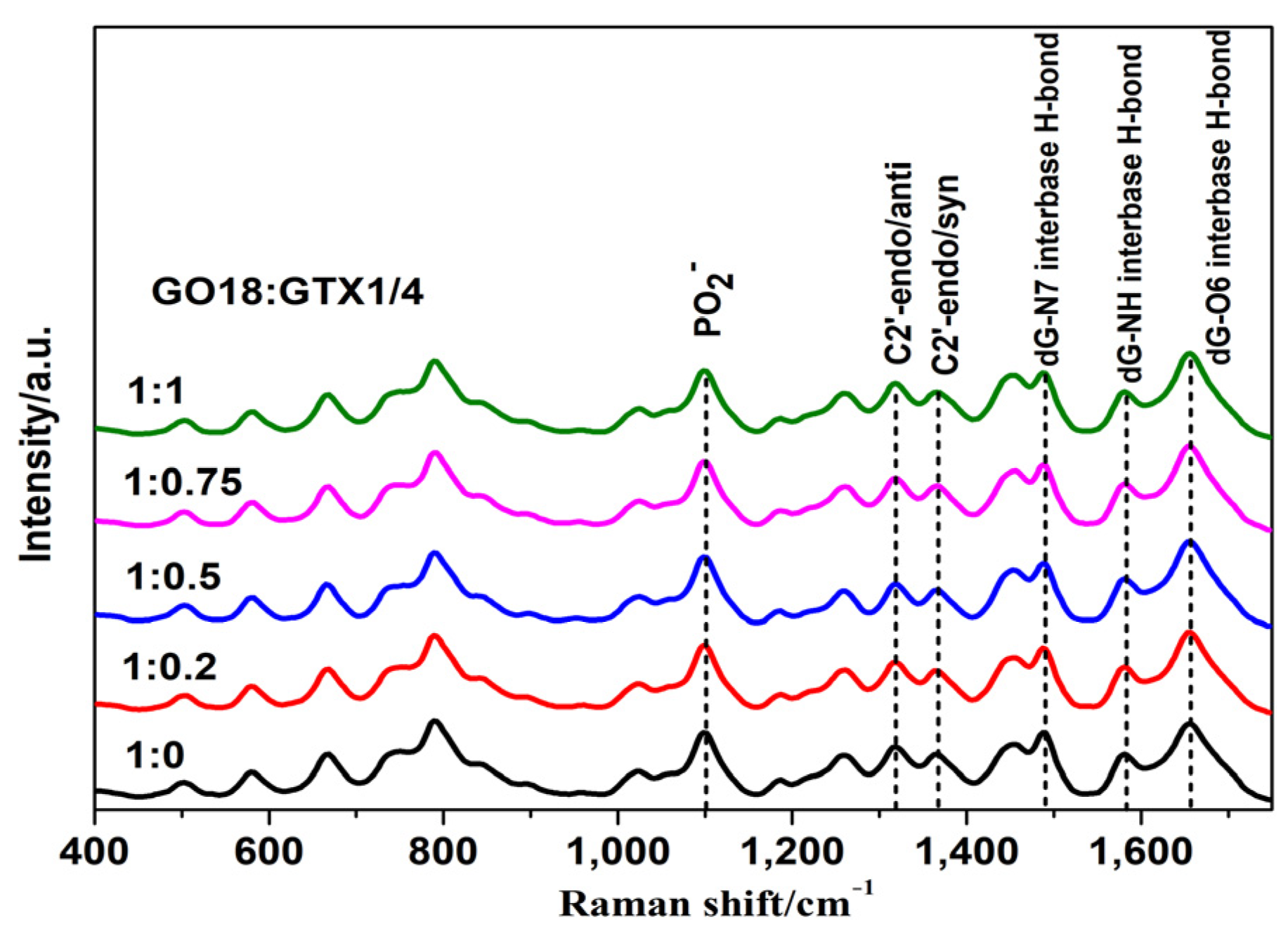
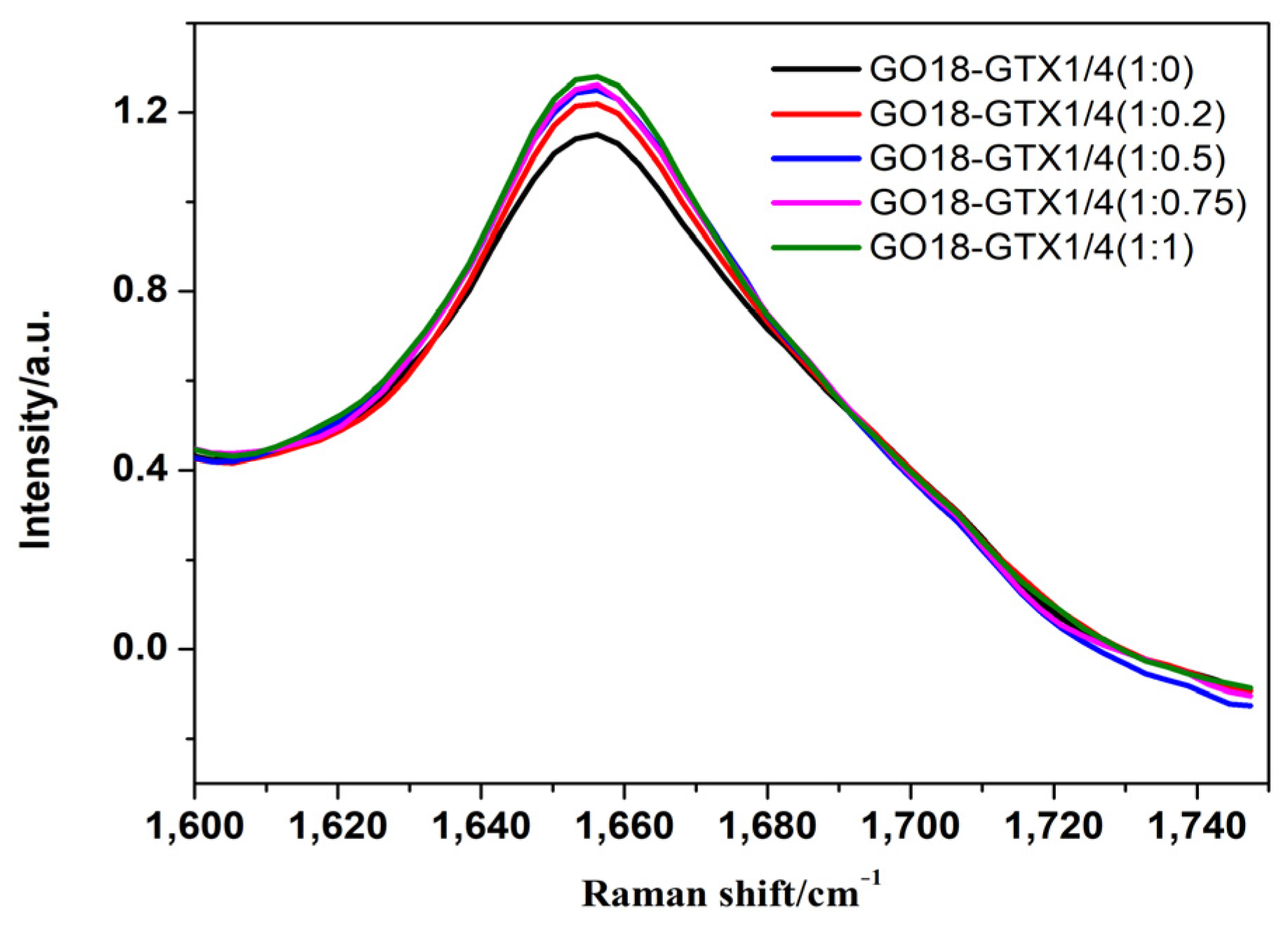

Publisher’s Note: MDPI stays neutral with regard to jurisdictional claims in published maps and institutional affiliations. |
© 2022 by the authors. Licensee MDPI, Basel, Switzerland. This article is an open access article distributed under the terms and conditions of the Creative Commons Attribution (CC BY) license (https://creativecommons.org/licenses/by/4.0/).
Share and Cite
Liu, Y.; He, L.; Zhao, Y.; Cao, Y.; Yu, Z.; Lu, F. Optimization of Surface-Enhanced Raman Spectroscopy Detection Conditions for Interaction between Gonyautoxin and Its Aptamer. Toxins 2022, 14, 49. https://doi.org/10.3390/toxins14010049
Liu Y, He L, Zhao Y, Cao Y, Yu Z, Lu F. Optimization of Surface-Enhanced Raman Spectroscopy Detection Conditions for Interaction between Gonyautoxin and Its Aptamer. Toxins. 2022; 14(1):49. https://doi.org/10.3390/toxins14010049
Chicago/Turabian StyleLiu, Yan, Lijuan He, Yunli Zhao, Yongbing Cao, Zhiguo Yu, and Feng Lu. 2022. "Optimization of Surface-Enhanced Raman Spectroscopy Detection Conditions for Interaction between Gonyautoxin and Its Aptamer" Toxins 14, no. 1: 49. https://doi.org/10.3390/toxins14010049
APA StyleLiu, Y., He, L., Zhao, Y., Cao, Y., Yu, Z., & Lu, F. (2022). Optimization of Surface-Enhanced Raman Spectroscopy Detection Conditions for Interaction between Gonyautoxin and Its Aptamer. Toxins, 14(1), 49. https://doi.org/10.3390/toxins14010049





